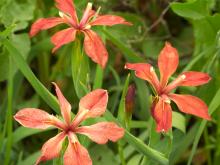Wildflowers, Grasses and Other Nonwoody Plants
Media

Species Types
Scientific Name
Impatiens capensis
Description
Many Missouri children learn about this orange-flowered native plant by playing with the juicy green seedpods, which, when ripe, "explode" upon the slightest touch. This is jewelweed's mechanism for seed dispersal, and it's the reason for the name "touch-me-not."
Media

Species Types
Scientific Name
Lobelia cardinalis
Description
Cardinal flower provides a splash of bright red along streams and rivers, in bottomland forests, in ditches by roads, and in other wet places. It's a long-blooming Missouri native wildflower.
Media

Species Types
Scientific Name
Iris fulva
Description
This attractive, copper-colored iris is gaining in popularity as a garden plant even though its numbers are declining in the wild. Like many other native plants, copper iris is hardy, low-maintenance, and has few pest or disease problems.
See Also
About Wildflowers, Grasses and Other Nonwoody Plants in Missouri
A very simple way of thinking about the green world is to divide the vascular plants into two groups: woody and nonwoody (or herbaceous). But this is an artificial division; many plant families include some species that are woody and some that are not. The diversity of nonwoody vascular plants is staggering! Think of all the ferns, grasses, sedges, lilies, peas, sunflowers, nightshades, milkweeds, mustards, mints, and mallows — weeds and wildflowers — and many more!





















